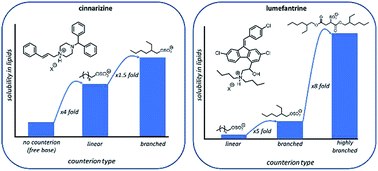API ionic liquids: probing the effect of counterion structure on physical form and lipid solubility†
Abstract
Lipid based formulations (LBFs) are extensively utilised as an enabling technology in drug delivery. The use of ionic liquids (ILs) or lipophilic salts (LS) in drug delivery has also garnered considerable interest due to unique solubility properties. Conversion of active pharmaceutical ingredients (API) to ILs by pairing with an appropriately lipophilic counterion has been shown to decrease melting point of the salt complex and improve solubility in LBFs. However, the relationship between the structure of the counterion, the physicochemical properties of the resulting salts and solubility in LBFs has not been systematically explored. This study investigates the relationship between alkyl sulfate counterion structure and melting temperature (Tm or Tg) in addition to LBF solubility, utilizing cinnarizine and lumefantrine as model weakly basic APIs. Three series of structurally diverse alkyl sulfate counterions were chosen to probe this relationship. Pairing cinnarizine and lumefantrine with a majority of these alkyl sulfate counterions resulted in a reduction in melting temperature and enhanced solubility in model medium chain and long chain LBFs. The chain length of the alkyl sulfate plays a crucial role in performance, and consistently branched alkyl sulfate counterions perform better than straight chain alkyl sulfate counterions, as predicted. Most interestingly, trends in counterion performance were found to be consistent across two APIs with disparate chemical structures. The findings from this study will facilitate the design of counterions which enhance solubility of ionisable drugs and unlock the potential to develop compounds previously restrained by poor solubility.



 Please wait while we load your content...
Please wait while we load your content...